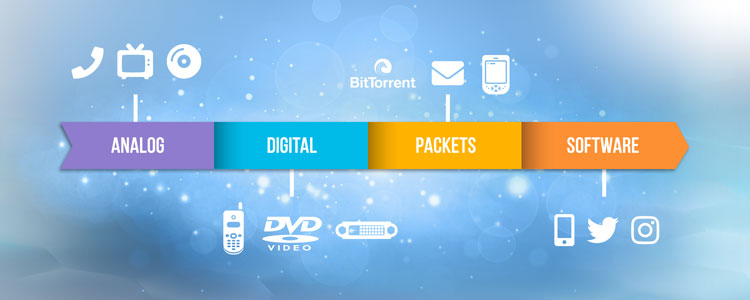Why transform the matrix?
Matrix switch vs matrix switching
‘Matrix switch’ is a term that describes a certain type of circuit switch that includes multiple inputs and multiple outputs, and an interface that allows each output to be independently connected to an input signal. An AV matrix switch is the big expensive piece of hardware at the center of most AV distribution systems ever deployed. The matrix switch used to be a necessary evil.
‘Matrix switching’ is the process of delivering signals from sources to destinations with minimal impact on the signals themselves. Matrix switching is the purpose of a matrix switch, and the core capability at the heart of AV signal distribution. Without the ability to deliver images and sound from sources to destinations, we could not realize any of the broad range of applications that pro AV delivers today. Switch vs switching – why split these hairs? Because it is time to recognize it is possible to separate matrix switching from the matrix switch.
Matrix switches exist because they are easy to manufacture, not because they are well-suited to the job. Matrix switching is simply a capability requirement – a recognition that end-user applications demand flexibility and quality from the underlying hardware. Flexibility and quality are all that matter to end users. They don’t care, or likely even know, what hardware is used to deliver it.
Historical communication trends
The trend of moving matrix switching away from the matrix switch and into the Ethernet network is inevitable, and parallels the same evolution that all electronic communication types have undergone.
All electronic communications follow the same trajectory from analog beginnings to flexible software platforms.
In the early days of new electronic communication, analog signals were used. Examples include the early telephone network, composite and component video, record players and FM radio. Eventually, the electronics needed to digitize the signal become common and cheap enough that the reliability of digital signalling can be enjoyed. We moved on to PBX phone networks, HDMI video and HDBaseT, CDs and satellite radio. These represent the end of the line for circuit switches. As Ethernet speeds and popularity grow, signals transition to the world of packets: voice over IP, Napster, and early streaming radio.
“Matrix switches exist because they are easy to manufacture, not because they are well-suited to the job.”
This is where pro AV video distribution stands today – ripe for transition from matrix switches to matrix switching on Ethernet networks.
SDVoE is enabling AV signal distribution to manage these last two transitions together. SDVoE is the only technology for distributing AV signals across Ethernet networks without damaging the video signal. However, SDVoE also provides a software platform, so that AV systems can be fully defined by the software that manages them. When your musical mood changes today, you ask Sonos to play something different – no more getting up to change the record. When your business technology needs change tomorrow, SDVoE makes it easy to reconfigure your signal distribution system – no more throwing expensive gear in the garbage and replacing it.
How is SDVoE transforming the matrix?
Augmenting the traditional capabilities of the matrix switch
SDVoE delivers capabilities far beyond that of a traditional matrix switch. Many SDVoE devices include a powerful AV processing unit which enables functions such as:
- Scaling
- Instant switching
- Video wall image cropping
- Multiview/compositing
- Independent routing of audio and video
- Audio downmixing
- USB transport
Leveraging software to maximize flexibility
SDVoE stands for software-defined video over Ethernet. Today’s world is all about software, for a good reason. Software is more adaptable than hardware. In the hardware-defined world of traditional AV, a system’s function is fully defined and locked-in when assembled. If you build a video wall controller, you have a video wall controller, now and forever. However, business needs change, and system demands change. How many times has a working AV system been torn out and replaced, at great expense, because the user’s needs changed? Or worse, how many times has a working AV system been left unused, because the user’s needs changed, but there was no budget for a replacement?
“SDVoE provides flexibility to adapt AV systems to evolving business needs.”
By creating a platform on which software defines the application, SDVoE provides the flexibility to adapt AV systems to evolving business needs. Just as you’d install new software to give your PC new capabilities, SDVoE systems can be updated and adjusted by installing new control software.
Leaving the walled garden of proprietary hardware
SDVoE defines the standard protocols and behavior of an SDVoE device and provides a control API that is standard across vendors. Because everything from the API down is standardized and carefully controlled, SDVoE devices exhibit the style of interoperability familiar to the IT world. A ZeeVee encoder works seamlessly with a Christie projector, while a NETGEAR switch automatically configures both of those devices. While there is still room for differentiation in the hardware (Dell vs HP, for example), it’s the software that determines what the system can do.
Although the hardware may be quite different, these computers can communicate seamlessly with one another. It’s the software that’s installed which defines what they are actually capable of.
Conclusion
When the rubber meets the road in AV, all that matters is good user experience – the system should be easy to use and deliver high-quality audio and video every time. For decades, the matrix switch was the only equipment that could deliver on these requirements.
Today, a new approach exists. SDVoE allows matrix switch ‘plumbing’ to be swapped for Ethernet while maintaining audio and video performance, and improving everything else about the system. It is easier to design, easier to install, easier to manage, and easier to use. It will grow and evolve with the users of the system. It will save time and cost for the owners of the system. The designer and installers will be more efficient and enjoy more business as a result.
We still need matrix switching, but we no longer need the matrix switch. SDVoE is the matrix transformed.
Topics
Stay
informed
Keep up to date on SDVoE Alliance news and events. Subscribe to our newsletter.



